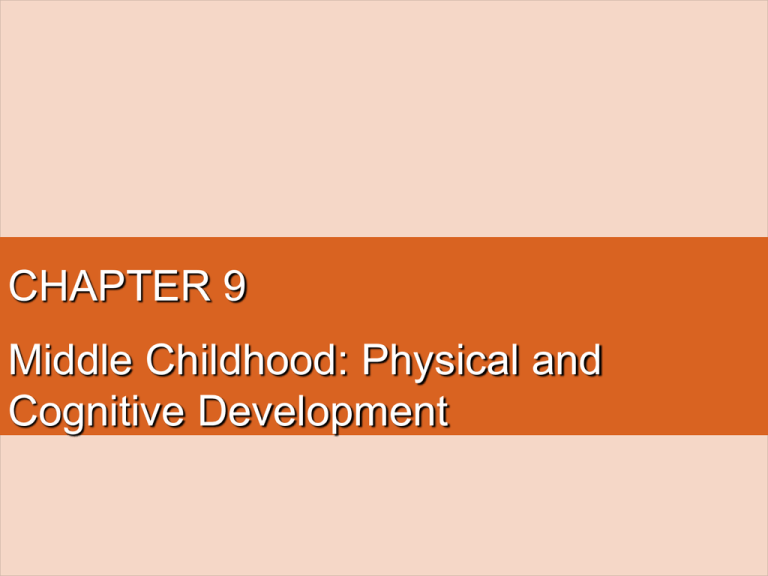
CHAPTER 9
Middle Childhood: Physical and
Cognitive Development
Growth Patterns
Growth Patterns
• Middle childhood growth
– Defined from ages 6 to 12
– Child’s body weight doubles
• Middle childhood nutrition
– 4- to 6-year-olds need 1,400 to 1,800 calories per day
– Healthful to eat fruits, vegetables, fish, poultry, and
whole grains
– Limit intake of fats, sugar, and starches
Fig. 9-1, p. 178
Gender Similarities and Differences in Physical
Growth
• Boys
– Slightly heavier and taller than girls through the age of
9 or 10
– Develop more muscle
– Spurt and grow taller and heavier than girls after
about 13 or 14
• Girls
– Have adolescent growth spurt and surpass boys in
height and weight until about 13 or 14
– Develop more fat
Overweight in Children
• Between 16% and 25% of children and
adolescents in the United States are overweight
or obese.
• Most overweight children become overweight
adults.
• Overweight children rejected by peers, poor at
sports, and less likely to be seen as attractive in
adolescence
• At greater risk of health problems throughout life
Fig. 9-2, p. 179
Causes of Being Overweight
• Heredity contributes to being overweight.
• Overweight parents may have poor exercise
habits, encourage overeating, and keep
unhealthful food in the home.
• Children who watch TV extensively burn fewer
calories and are more likely to be overweight
adolescents.
Motor Development
Gross Motor Skills
• Age 6 or 7, children
– hop, jump, climb, pedal, and balance bicycle
• Age 8 to 10, children
– develop balance, coordination, and strength, which
allows them to engage in gymnastics and team sports
• Myelination
– Neural pathways that connect the cerebellum to the
cortex are more myelinated
• Reaction time
– Improves (decreases) from early childhood to about
age 18, but there are individual differences
Fine Motor Skills
• At 6 to 7 years, children can tie shoelaces and
hold pencils like adults do.
• At 6 to 7 years, children can fasten buttons, zip
zippers, brush teeth, wash themselves,
coordinate a knife and fork, and use chopsticks.
• Fine motor skills improve throughout childhood.
Gender Differences
• Boys
– More forearm strength, which is good for swinging a
bat or throwing a ball
– At puberty, sex differences favoring boys increases
• Girls
– Greater limb coordination and overall flexibility aiding
them in dancing, gymnastics, and balancing
• Between middle childhood and adolescence
– Physical activities become increasingly stereotyped
by children as being masculine or feminine
Exercise and Fitness
• Physically active adolescents have better selfimage and coping skills than those who are
inactive.
• Cardiac and muscular fitness is developed by
participating in running, walking quickly,
swimming laps, bicycling, or jumping rope for
several minutes at a time.
• Schools and parents tend to focus on sports
such as baseball and football, which are less apt
to promote fitness.
Children with Disabilities
Children with Disabilities
• Children with disabilities identified during middle
childhood years when child enters school
• Attention deficit/hyperactivity disorder (ADHD)
– Child shows excessive inattention, impulsivity, and
hyperactivity
– The degree of hyperactivity is crucial
– Typically occurs by age 7
– Impairs ability to function at school
– Sometimes overdiagnosed to encourage better
behavior at school
Causes of ADHD
• Genetic component to ADHD involving the brain
chemical dopamine
• Brain imaging has shown differences in the brain
chemistry of children with ADHD.
• ADHD may be due to lack of executive control of
the brain over motor and more primitive
functions.
• Stimulants are effective with ADHD because
they promote the activity of the brain chemicals
dopamine and noradrenaline, stimulating the
“executive center” of the brain to control more
primitive areas of the brain.
Learning Disabilities
• Some children who are intelligent and provided
with enriched home environments cannot learn
how to read (dyslexia) or do simple math
problems.
• Children are diagnosed with a learning disability
when performing below the level expected for
their age and intelligence, and when there is no
evidence of other handicaps such as vision or
hearing problems, retardation, or socioeconomic
disadvantage.
• The younger the child when remediation occurs,
the better the chances of compensating for the
disability.
Origins of Dyslexia
• Dyslexic individuals
– Sensory and neurological problems may contribute to reading
problems.
– Genetic factors may give rise to neurological problems or
circulation problems in the left hemisphere of the brain.
– Problems in the angular gyrus may give rise to reading
problems.
• Dyslexic statistics
– 25% to 65% of children who have one dyslexic parent are
dyslexic themselves.
– About 40% of the siblings of children with dyslexia are dyslexic.
Fig. 9-3, p. 167
Educating Children with Disabilities
• Treatment for dyslexia focuses on remediation.
• Given highly structured exercises to help them
become aware of how to blend sounds to form
words
• Evidence is mixed on whether placing disabled
children in separate classes can also stigmatize
them and segregate them from other children.
• Mainstreaming: disabled children are placed in
regular classrooms that have been adapted to
their needs
Cognitive Development
Cognitive Development
• Children make enormous strides in their
cognitive development during middle childhood
as their thought processes and language
become more logical and complex.
Piaget: The Concrete-Operational Stage
• Child enters concrete-operational stage around age 7
• Concrete-operational thought is reversible and flexible
• Children can reverse mathematical operations (e.g., 2 +
3 = 5 can be reversed to 5 – 3 = 2)
• Children less egocentric and are able to engage in
decentration (focus on multiple parts of a problem at
once)
• At age 7, children understand law of conservation
Piaget: The Concrete-Operational Stage
(cont’d)
• Transitivity
– If A exceeds B in some property and B exceeds C,
then A must also exceed C
• Seriation
– Ability to place objects in a series by age, height,
weight
– Children can seriate two dimensions at once
Fig. 9-4, p. 185
Piaget: The Concrete-Operational Stage
(cont’d)
• Class inclusion
– Focusing on two subclasses and larger subclass at
the same time
– Concrete-operational children understand class
inclusion.
• Piaget’s theory applied to education
– Learning involves active discovery.
– Instruction should be geared to the child’s level of
development.
– Learning to take into account the perspectives of
others to develop cognition and morality
Moral Development: The Child as Judge
Moral Development: The Child as a Judge
• On a cognitive level, moral development
concerns the basis on which children make
judgments that an act is right or wrong.
• May be influenced by the values of the cultural
settings in which they are reared, but also reflect
the orderly unfolding of cognitive processes
• Moral reasoning is related to the child’s overall
cognitive development.
Piaget’s Theory of Moral Development
• Piaget believed children’s moral judgments
develop in two overlapping stages: moral
realism and autonomous morality.
• Moral realism
– Behavior is considered to be correct when it conforms
to authority or to the rules of the game
– Immanent justice or automatic retribution
• Thinking that negative experiences are punishment for prior
misdeeds, even when realistic causal links are absent
• Ages 9 to 11, children show autonomous
morality
– Moral judgments become self-governed
Kohlberg’s Theory of Moral Development
• Preconventional level
– Children base moral judgments on the consequences of their
behavior
– Stage 1: toward being obedient and punishment
– Stage 2: good behavior allows people to satisfy their own needs
and the needs of others
• Conventional level
– Right and wrong are judged by conformity to conventional
standards of right and wrong
– Stage 3 focuses on being a good boy or girl in order to meet the
needs and expectations of others
– Stage 4 focuses on moral judgments met to keep social order
– Stages 3 and 4 emerge during middle childhood
Kohlberg’s Theory of Moral Development
(cont’d)
• Postconventional level
– Moral reasoning is based on person’s own moral
standards
– Adolescents and adults participate in moral reasoning
at this level
Information Processing: Learning,
Remembering, Problem Solving
Information Processing: Learning,
Remembering, Problem Solving
• Development of selective attention
• Development of the capacity of memory and of
children’s understanding of the processes of
memory
• Development of the ability to solve problems as,
for example, by finding the correct formula and
applying it
Development of Selective Attention
• Ability to focus one’s attention and screen out
distractions advances steadily
• Preoperational children
– Engaged in problem solving
– Tend to focus their attention on one element of the problem at a
time
• Major reason they lack conservation
• Concrete-operational children
– Attend to multiple aspects of the problem at once
• Permits them to conserve number and volume
Developments in The Storage and Retrieval of
Information
• Sensory memory
– Visual impression of an object lasting for a fraction of
a second
Working Memory (Short-Term Memory)
• Focus on a stimulus in the sensory register
– Tends to be retained in working memory for up to 30 seconds
after the trace of the stimulus decays
• Memory function in middle childhood
– Similar to adult-like organization and strategies
– Quantitative improvement through adolescence
• Auditory stimuli can be maintained longer in short-term
memory than can visual stimuli
• Promoting memory
– Encode visual stimuli as sounds
– Rehearsing sounds that can be repeated out loud or mentally
Fig. 9-6, p. 190
Long-Term Memory
• Vast storehouse of information containing
names, dates, places
• May last days, years, or a lifetime
• No known limit to the amount of information that
can be stored in long-term memory
• Older children more likely than younger children
to use rote rehearsal, or repetition, to remember
• Elaborative strategy
– Relating new material to known material
Organization in Long-Term Memory
• Knowledge of concepts advances
• Storehouse of long-term memory becomes
organized according to categories
• Preschoolers tend to organize their memories by
grouping objects that share the same function.
• Children are more likely to recall accurate
information.
• Knowledge in a particular area increases the
capacity to store and retrieve related
information.
Development of Recall Memory
• Memory ability good indicator of child’s
cognitive ability
• 4th graders more likely to categorize and recall
pictures than 2nd graders
Development of Metacognition and
Metamemory
• Metacognition
– Children’s knowledge and control of their cognitive abilities
– Shown by ability to formulate problems, awareness of the
processes required to solve a problem, activation of cognitive
strategies, maintaining focus on the problem, and checking
answers
• Metamemory
– Aspect of metacognition that refers to children’s awareness of
the functioning of their memory
– Store and retrieve information more effectively
– Show more knowledge of strategies that can be used to facilitate
memory
Intellectual Development, Creativity, and
Achievement
Intellectual Development, Creativity, and
Achievement
• Intelligence
– Child’s underlying competence or learning ability
• Achievement
– Child’s acquired competencies or performance
• Competencies underlying intelligence manifest
themselves during middle childhood when
children are exposed to formal schooling.
Theories of Intelligence
• Spearman
– Intelligence has a common underlying factor, “g”
(general intelligence), which represents broad
reasoning and problem-solving abilities.
• Thurstone
– Intelligence consists of several specific factors or
primary mental abilities, such as the ability to learn
the meaning of words and visual-spatial abilities.
Theories of Intelligence (cont’d)
• Sternberg
– Constructed a three-part, or “triarchic,” theory of
intelligence
– Part 1: analytical intelligence
• Academic ability
– Part 2: creative intelligence
• Ability to cope with novel situations and to profit from
experience
– Part 3: practical intelligence
• Adapt to the demands of their environment, including the
social environment
Fig. 9-8, p. 193
Theories of Intelligence (cont’d)
• Gardner
– Believed intelligence reflects more than academic
ability
– Theory based on multiple intelligences
– Multiple intelligences can include verbal ability,
logical-mathematical reasoning, spatial intelligence,
bodily-kinesthetic, musical, interpersonal, and
personal knowledge.
Fig. 9-9, p. 194
Measurement of Intellectual Development
• Binet-Simon scale
– Yields a score called a mental age (MA)
– MA shows the intellectual level at which a child is
functioning
• Stanford-Binet Intelligence Scale
– Yields an intelligence quotient, or IQ
– IQ states the relationship between a child’s mental
age and his/her actual or chronological age (CA)
– IQ equals MA divided by CA times 100
• IQ today is compared to those performances of
other people of the same age
Table 9-2, p. 195
Measurement of Intellectual Development
(cont’d)
• Wechsler scales
– Developed for use with school-aged children (WISC),
younger children (WPPSI), and adults (WAIS)
– Groups test questions in subtests that measure
different intellectual tasks
– Suggests children’s strengths and weakness as well
as provide overall measures of intellectual functioning
The Testing Controversy
• Cultural bias
– Scoring well on intelligence test requires a certain
type of cultural experience
• Culture-free
– Evaluates reasoning ability through the child’s
comprehension of the rules that govern a progression
of geometric designs
– Middle-class children still outperform lower-class
children
– Tests do not predict academic success as well as
other tests
Fig. 9-12, p. 198
Patterns of Intellectual Development
• School may help crystallize intellectual
functioning around age 6.
• Middle childhood
– Undergo more stable patterns of gains in intellectual
functioning
– Intelligence tests gain greater predictive power
– Individual differences still exist
• Changes in the home, socioeconomic
circumstances, and education influence changes
in IQ scores.
Intellectual Disability
• Mental retardation (MR)
– Disability characterized by significant limitations both
in intellectual functioning and in adaptive behavior as
expressed in conceptual, social, and practical
adaptive skills
– Involves IQ score of no more than 70 to 75
• Down syndrome children
– More likely to be moderately retarded
– Can learn to speak, dress, feed, clean themselves,
and eventually engage in useful work
• Cultural-familial retardation
– Biologically normal children that do not develop
normally due to impoverished home environment
Giftedness
• Involves more than excellence on the tasks
provided by standard intelligence tests
• Educators’ criteria for intelligence
– Outstanding abilities
– Capable of high performance in a specific academic
area, such as language or mathematics
– Show creativity, leadership, distinction in the visual or
performing arts, or bodily talents, as in gymnastics
and dancing
Socioeconomic and Ethnic Differences in IQ
• Lower-class African-American children obtain IQ scores
between 10 and 15 points lower than those obtained by
middle- and upper-class children.
• African-American, Latino- and Latina-American, and
Native-American children all tend to score below the
norms for European Americans.
• Youths of Asian descent frequently outscore youths of
European backgrounds on achievement tests in math
and science, including the math portion of the SAT.
Creativity and Intellectual Development
• Creativity
– Ability to do things that are novel and useful
– Creative children and adults solve problems where
there is no tried and true solution.
– Take chances and appreciate art and music
– Challenge social norms
– Moderate relationship between IQ score and creativity
• Convergent thinking
– Process children use to answer questions on an IQ
test
• Divergent thinking
– Child associates freely to the elements of the
problem; more creative
Determinants of Intellectual Development
• MZ twins have a high concordance rate on IQ scores
(+0.85)
• MZ twins reared apart still show +0.67 correlation
• Correlation between children and natural parents vary
from about +0.40 to +0.59
• Heritability between 40% and 60%
• Stronger correlation of adoptive parents and adopted
children when IQ of adoptive parents was similar to IQ of
natural parents
• Environmental stimulation increases IQ whether child is
adopted, biological, or low SES.
Language Development and Literacy
Vocabulary and Grammar
• By age 6, vocabulary at 10,000 words
• Semantic sophistication by 7 to 9 years old
• Subtle advances made in articulation during
middle childhood
• Children use connectives (conjunctions) and can
form indirect object-direct object constructions
Methods of Teaching Reading
• Word-recognition method
– Associates visual stimuli with the sound combinations
that produce spoken words
• Phonetic method
– Children first learn to associate written letters and
letter combinations with the sounds they indicate
– Helps with decoding
• Sight vocabulary
– Recognizing useful words such as one’s name, and
such signs as danger, stop, and poison
Bilingualism: Linguistic Perspectives on the
World
• Approximately 50 million of Americans speak a
different language than English at home.
• Bilingual children not cognitively delayed
• Half of Spanish-speaking children at home are
proficient in both languages
• Bilingualism contributes to the complexity of the
child’s cognitive processes.
• Bilingual children understand symbols used in
language are arbitrary










